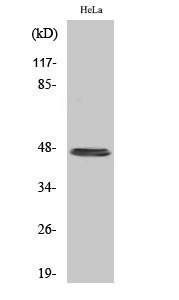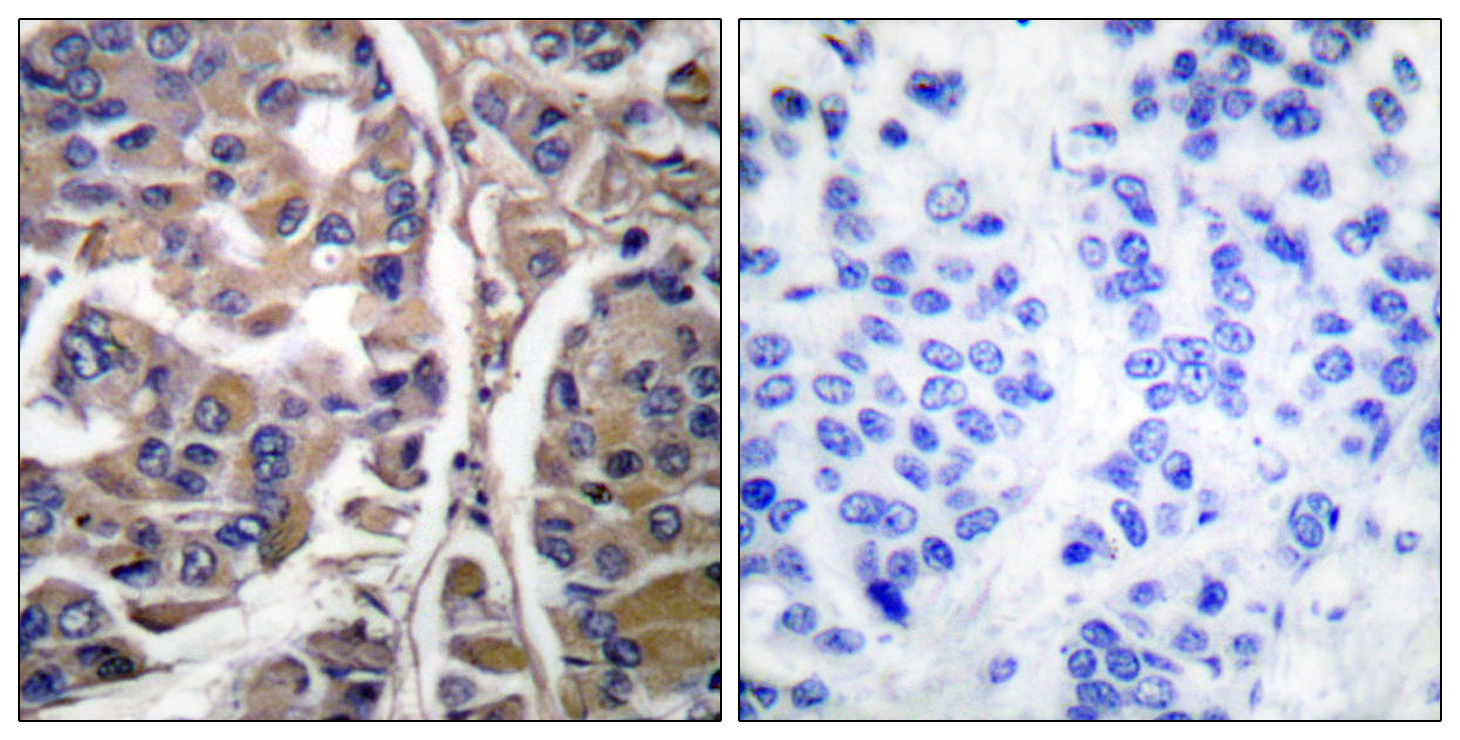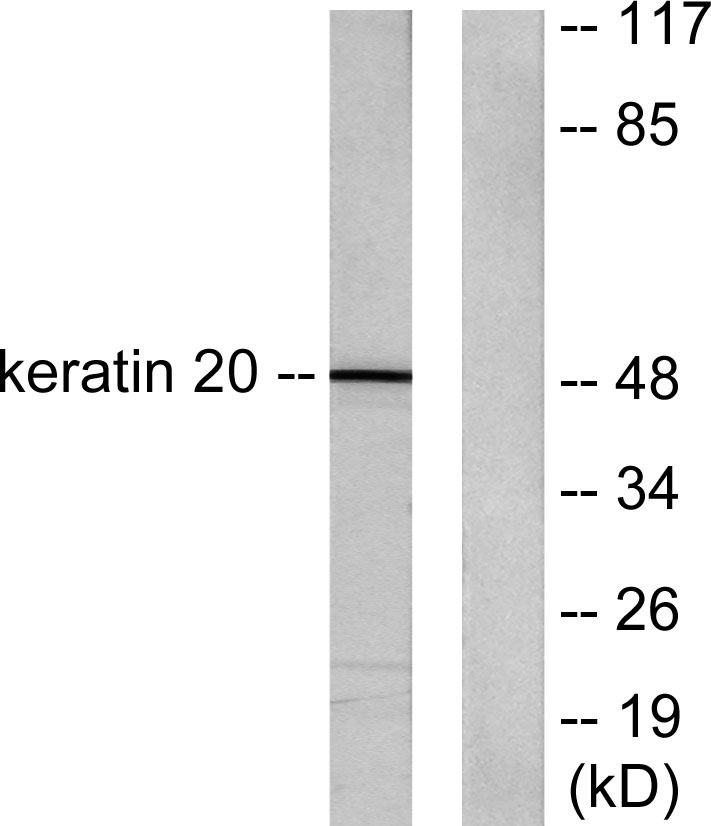Cytokeratin 20 Polyclonal Antibody
- Catalog No.:YT1270
- Applications:WB;IHC;IF;ELISA
- Reactivity:Human;Mouse;Rat
- Target:
- Cytokeratin 20
- Fields:
- >>Estrogen signaling pathway;>>Staphylococcus aureus infection
- Gene Name:
- KRT20
- Protein Name:
- Keratin type I cytoskeletal 20
- Human Gene Id:
- 54474
- Human Swiss Prot No:
- P35900
- Mouse Gene Id:
- 66809
- Mouse Swiss Prot No:
- Q9D312
- Rat Gene Id:
- 286912
- Rat Swiss Prot No:
- P25030
- Immunogen:
- The antiserum was produced against synthesized peptide derived from human Keratin 20. AA range:375-424
- Specificity:
- Cytokeratin 20 Polyclonal Antibody detects endogenous levels of Cytokeratin 20 protein.
- Formulation:
- Liquid in PBS containing 50% glycerol, 0.5% BSA and 0.02% sodium azide.
- Source:
- Polyclonal, Rabbit,IgG
- Dilution:
- WB 1:500 - 1:2000. IHC 1:100 - 1:300. IF 1:200 - 1:1000. ELISA: 1:10000. Not yet tested in other applications.
- Purification:
- The antibody was affinity-purified from rabbit antiserum by affinity-chromatography using epitope-specific immunogen.
- Concentration:
- 1 mg/ml
- Storage Stability:
- -15°C to -25°C/1 year(Do not lower than -25°C)
- Other Name:
- KRT20;Keratin; type I cytoskeletal 20;Cytokeratin-20;CK-20;Keratin-20;K20;Protein IT
- Observed Band(KD):
- 49kD
- Background:
- The protein encoded by this gene is a member of the keratin family. The keratins are intermediate filament proteins responsible for the structural integrity of epithelial cells and are subdivided into cytokeratins and hair keratins. The type I cytokeratins consist of acidic proteins which are arranged in pairs of heterotypic keratin chains. This cytokeratin is a major cellular protein of mature enterocytes and goblet cells and is specifically expressed in the gastric and intestinal mucosa. The type I cytokeratin genes are clustered in a region of chromosome 17q12-q21. [provided by RefSeq, Jul 2008],
- Function:
- developmental stage:First detected at embryonic week 8 in individual 'converted' simple epithelial cells of the developing intestinal mucosa. In later fetal stages, synthesis extends over most goblet cells and a variable number of villus enterocytes. In the developing gastric and intestinal mucosa, expressed in all enterocytes and goblet cells as well as certain 'low-differentiated' columnar cells, whereas the neuroendocrine and Paneth cells are negative.,function:Plays a significant role in maintaining keratin filament organization in intestinal epithelia. When phosphorylated, plays a role in the secretion of mucin in the small intestine.,miscellaneous:There are two types of cytoskeletal and microfibrillar keratin: I (acidic; 40-55 kDa) and II (neutral to basic; 56-70 kDa).,PTM:Hyperphosphorylation at Ser-13 occurs during the early stages of apoptosis but becomes less prominent during t
- Subcellular Location:
- Cytoplasm .
- Expression:
- Expressed predominantly in the intestinal epithelium. Expressed in luminal cells of colonic mucosa. Also expressed in the Merkel cells of keratinized oral mucosa; specifically at the tips of some rete ridges of the gingival mucosa, in the basal layer of the palatal mucosa and in the taste buds of lingual mucosa.
- June 19-2018
- WESTERN IMMUNOBLOTTING PROTOCOL
- June 19-2018
- IMMUNOHISTOCHEMISTRY-PARAFFIN PROTOCOL
- June 19-2018
- IMMUNOFLUORESCENCE PROTOCOL
- September 08-2020
- FLOW-CYTOMEYRT-PROTOCOL
- May 20-2022
- Cell-Based ELISA│解您多样本WB检测之困扰
- July 13-2018
- CELL-BASED-ELISA-PROTOCOL-FOR-ACETYL-PROTEIN
- July 13-2018
- CELL-BASED-ELISA-PROTOCOL-FOR-PHOSPHO-PROTEIN
- July 13-2018
- Antibody-FAQs
- Products Images

- Western Blot analysis of various cells using Cytokeratin 20 Polyclonal Antibody diluted at 1:500

- Immunohistochemistry analysis of paraffin-embedded human breast carcinoma tissue, using Keratin 20 Antibody. The picture on the right is blocked with the synthesized peptide.

- Western blot analysis of lysates from HeLa cells, using Keratin 20 Antibody. The lane on the right is blocked with the synthesized peptide.



